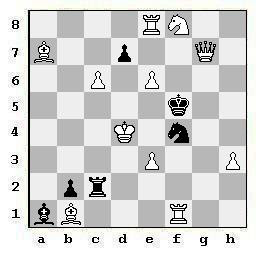Some years ago the First Solving Contest of the Chess Club Triandria (Salonica, Greece) has been organized on the Sunday 2002-12-01.
The problems were selected by Carlo DeGrandi.
There were 3 judges : Costas Youvantsioudis, Costas Papadopoulos, Carlo deGrandi.
Committee for examination of Objections : Byron Zappas, Odysseas Vazelakis, Pantelis Martoudis.
There were two groups each having with 12 solvers, having 2 hours time to solve 4 problems (only direcmates, with 5 points per problem, 20 points maximum).
Group A had to solve a two-mover, a three-mover, a four-mover and a five-mover.
Group B had to solve (Teenagers) should solve four two-movers.
Winners in Group A were the following :
1. Costas Prentos (20 points, in 45 minutes), (Prize : Carved plate and 120€)
2. G. Papadopoulos (15, 53'), (Prize : Medal and 70€)
3. N. Papachristou (5, 67'), (Prize : Madal and 50€).
Other participants were (by order of application) : Tsikrikonis P., Cryssostomidis A., Exissoglou G., Eleftheriadis A., Kakousatze I., Fetihakis D., Kelessiadis G., Kyvelos S., Youvantsioudis C..
Participants in Group B (teenagers) (by finishing order) :
Boutsioukis N., Solakidis P., Gerochristos G., Constantinidis C., Papadopoulos P., Frangoulis L., Pahygiannakis L., Costopoulos D., Verikios G., Georgiadis B., Papavassiliou Ch., Siozos K..
All the participants were awarded with books.
Sponsors of the event : Asterias, Massoutis, Ygro Pyr, Koudigelis K., Catselis.
We now present the 8 problems of the Contest, 4 'easier' problems for the Group-B and 4 'more difficult' problems for Group-A.
Group B (teenagers), Time : 2 hours
 | (Problem 212) Yuri Antonov, Hlas Ludu, 1981 Mate in 2 moves. #2 (8+6) |
| [3K4/2pR4/2p4S/2Pskp1S/4p3/4R3/6B1/3Q4] | |
Tries : {1.Rd6? cxd6!}, {1.Rxc7? / Sf7+? Ke6!}, {1.Re7+? Sxe7!}, {1.Sg4+? fxg4!}, {1.Rxe4+? fxe4!}, {1.Qa1+? Sc3!}, {1.Qxd5+? cxd5!}, {1.Qd4+? Kxd4!}.
Let us observe a little closer the play after the next try, in order to compare with the post-key play :
{1.Bh3?
1...S~ (a) 2.Re7# (A)
1...f4 (b) 2.Sf7# (B)
1...Ke6 (c) 2.Rxe4# (C)
1...Sf4!}
Κλειδί : 1.Qb3! (zz).
1...Kd4 2.Qc3#
1...S~ (a) 2.Sf7# (B)
1...f4 (b) 2.Rxe4# (C)
1...Ke6 (c) 2.Re7# (A)
The problem contains the theme [Lacny 2x3] (two phases and three variations with cyclic permutation of mates).
| Theme Lacny pxv. It is developed over various phases (the number of phases is p). In one phase there are some (a b c ... z) defences (the number of variations is v) which are answered with the mates (A B C ... Z). In another phase the same (a b c ... z) defences are answered with a cyclic permutation of the mates (B C ... Z A). The theme is named after the composer Ludovit Lacny, who has published in 1949 the first problem with relevant content. |
 | (Problem 213) Alexandr Kuzovkov Second Honourable Mention, Bachernich Charpkov, 1982 Mate in 2 moves. #2 (4+4) |
| [8/5K2/6Bk/4B3/Q1p5/8/s7/2q5] | |
Tries : {1.Kg6? / Rf2? / Rg3? d5!}, {1.Qxd7? Ke5!}, {1.Qf5+? Kxf5!}, {1.Qe5+? Kxe5!}, {1.Qd5+? Kxd5!}, {1.Rg5? / Rg4+? Kf3!}, {1.Sg3+? / Sd2+? Kxe3!}.
Key : 1.Rd2! [2.Q(x)d5#]
1...Kf3 2.Qf5#
 | (Problem 214) Michael Lipton, Commendation, I R T 1996-1997 Mate in 2 moves. #2 (5+2) |
| [4B3/8/8/3Q3R/1k6/3s2B1/8/1K6] | |
Tries : {1.Qb3+? Kxb3!}, {1.Qc4+? Kxc4!}, {1.Qd4+? Kb3!}, {1.Qa5+? Kc4!}, {1.Qb5+? Kc3!}, {1.Be1+? Sxe1!}.
Key : 1.Rh3! (zz)
1...Sb2 / Sc1 / Se1 2.B(x)e1# / Bd6#
1...Se5 / Sf4 / Sc5 / Kc3 2.Be1#
1...Sf2 / Ka3 2.Bd6#
 | (Problem 215) Carlo deGrandi, original, 2000 Mate in 2 moves. #2 (5+4) |
| [8/5K2/6Bk/4B3/Q1p5/8/s4P2/2q5] | |
Tries : {1.Bf4+? Qxf4+!}, {1.Bg7+? Kg5!}.
Key: 1.Qd1! [2.Qh5#]
1...Qg5 2.Bg7#
1...Qf4+ 2.Bxf4#
1...Qxd1 2.Bf4#
Group A, Time : 2 hours
 | (Problem 216) Ignaas Vandemeulebrouke, B-Merksem, 1990 Mate in 2 moves. #2 (7+7) |
| [8/6r1/1B3ps1/3S4/2P1kpQp/8/2K2PS1/b7] | |
Tries : {1.Sxf4? Se5!}, {1.Qe2+? Kf5!}, {1.Qh5? f3!}, {1.Qxf4+? Sxf4!}, {1.Sxh4? / f3+? Ke5!}.
The solution follows :
Key : 1.Sxf4! [2.Sxg6#]
1...Be5 2.f3#
1...Ke5 2.Qe6#
1...f5 2.Qe2#
1...Se5 2.Sxf6#
1...Sxf4 2.Qxf4#
 | (Problem 217) Dr Hermann Weissauer, Tidskrift fuer Schack, 1987 Mate in 3 moves. #3 (9+11) |
| [1b3r2/1s3Sq1/2b1R3/4P1pP/1r2kpQ1/4B1ps/3R2K1/5S2] | |
Tries : {1.Sd6+? Bxd6!}, {1.Sh6? Qxh6!}, {1.Re8? Rxe8!}, {1.Rf6? Qxf6!}, {1.Qf3+? Kf5!}, {1.Qf5+? Kxf5+!}, {1.Bb6? Rxb6!}, {1.Bc5? Sxc5!}, {1.Kxh3? Bb5!}, {1.Rd4+? Rxd4!}, {1.Sxg3+? Kxe3+!}.
The solution follows :
Key : 1.Re7! [2.Qf3+ Kf5 3.Sxg3#]
1...Sg1 2.Bxg1 [3.Sxg3#] Rb3 / Rb4 3.R(x)d4#
1...Qxe5 2.Bg1 [3.Sxg3#]
___2...Sf2 / Sxg1 3.Sxg5#
___2...Rb3 / Rd4 3.R(x)d4#
1...Bxe5 2.Bc5 [3.Sxg3#]
___2...Sxc5 3.Sd6#
___2...Rb3 / Rd4 3.R(x)d4#
 | (Problem 218) Dr Hermann Weissauer, Diagrammes, 1981 Mate in 4 moves. #4 (7+11) |
| [br6/3p3p/3p4/pP5p/3S1kSK/4pP2/BQ3p2/5s2] | |
Tries : {1.Se2+? / Se6+? Kxf3!}, {1.Bd5? Bxd5!}.
The solution follows :
Key : 1.Qa3! [2.Qxd6#]
1...Bxf3 2.Qxd6+ Ke4 3.Bb1#
1...Rxb5 / Re8 2.Qxd6+ Re5 3.Qxe5#
1...Rb6 2.Qd3 [3.Qf5#]
___2...Sg3 3.Qxe3#
___2...Be4 3.Qxe4#
___2...Rxb5 3.Bd5 [4.Se2# / Qe4# / Qf5#]
______3...Sd2 4.Se2# / Qxe3# / Qf5#
______3...Rb2 / hxg4 4.Qe4# / Qf5#
______3...Sg3 4.Qxe3#
______3...Rxd5 4.Qe4#
______3...Bxd5 4.Qf5#
 | (Problem 219) A. F. Svanberg, Schachzeitung, September 1847 Mate in 5 moves. #5 (8+6) |
| [1S4R1/1S3s2/1p6/1k6/1p1P1s2/1P5q/K1P5/3B4] | |
Tries : {1.Sd6+? Sxd6!}, {1.c4+? bxc3 e.p.!}, {1.Be2+? Sxe2!}.
The solution follows :
Key : 1.Rg5+!
1...Qf5
___2.Rxf5+
______2...Sd5 3.Rxd5# / Be2#
______2...Se5
_________3.Bxe2+
____________3...Sxe2 4.Rxe5#
____________3...Sd3 4.Rxe5# / Bxd3#
_________3.Rxe5+ Sd5 4.Rxd5# / Be2#
___2.Be2+
______2...Sd3 3.Bxd3#
______2...Sxe2 3.Rxf5+ Se5 4.Rxe5#
1...Sd5 2.Rxd5#
1...Se5 2.Rxe5+ Sd5 3.Rxd5#
1...Sxg5 2.c4+ bxc3 e.p. 3.Sd6+
____________3...Kb4 4.Sc6#
____________3...Ka5 4.b4+ Kxb4 5.Sc6#
(This post in Greek language).











































